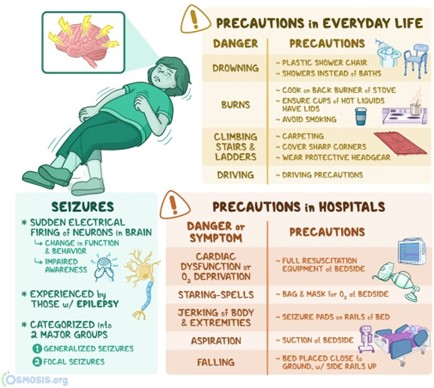A nurse is interpreting the ECG strip of a client who has bradycardia. Which of the following cardiac components should the nurse identify as the role of the P wave?
Slow repolarization of ventricular Purkinje fibers
Atrial depolarization
Early ventricular repolarization
Ventricular depolarization
The Correct Answer is B
The P wave is the first wave on the ECG strip and represents the electrical activity of the atria. It reflects the depolarization of the atrial myocardium, which is the process of changing the electrical charge of the cardiac cells from negative to positive, triggering a contraction. The P wave precedes the QRS complex, which represents ventricular depolarization, and the T wave, which represents ventricular repolarization.
The other options are not correct because:
a. Slow repolarization of ventricular Purkinje fibers. This statement is incorrect because it describes the U wave, which is a small and sometimes invisible wave that follows the T wave on the ECG strip. It reflects the repolarization of the ventricular Purkinje fibers, which are specialized cardiac cells that conduct electrical impulses to the ventricles. The U wave is more prominent in conditions that cause hypokalemia, such as diuretic use or vomiting.
c. Early ventricular repolarization. This statement is incorrect because it describes the ST segment, which is the flat line between the QRS complex and the T wave on the ECG strip. It reflects the early phase of ventricular repolarization, which is the process of restoring the electrical charge of the cardiac cells to negative after a contraction. The ST segment can be elevated or depressed in conditions that cause myocardial ischemia or injury, such as angina or myocardial infarction.
d. Ventricular depolarization. This statement is incorrect because it describes the QRS complex, which is the largest and most visible wave on the ECG strip. It reflects the depolarization of the ventricular myocardium, which triggers a ventricular contraction. The QRS complex follows the P wave and precedes the T wave on the ECG strip.
Nursing Test Bank
Naxlex Comprehensive Predictor Exams
Related Questions
Correct Answer is C
Explanation
Impaired tissue perfusion is a nursing diagnosis that indicates a decrease in oxygen and nutrient delivery to the tissues, resulting in cellular dysfunction and potential tissue damage or necrosis. It is the priority nursing diagnosis for a client who has varicose veins with ulcerations and lower extremity edema, as these are signs of chronic venous insufficiency, which is a condition in which the veins in the legs fail to return blood to the heart effectively, causing blood to pool and stagnate in the lower extremities. This leads to increased venous pressure, inflammation, and impaired wound healing, which can cause skin breakdown, infection, and tissue necrosis. The nurse should monitor the client's vital signs, peripheral pulses, capillary refill, skin color, temperature, and sensation, and implement interventions to improve venous return and prevent further complications, such as elevating the legs, applying compression stockings, encouraging ambulation, administering medications, and providing wound care.
Alteration in body image. This is a nursing diagnosis that indicates a negative perception or dissatisfaction with one's physical appearance or function. It may be applicable for a client who has varicose veins with ulcerations and lower extremity edema, as these may affect their self-esteem and social interactions. However, it is not the priority nursing diagnosis for this client, as it does not pose an immediate threat to their health or safety.
Alteration in activity tolerance. This is a nursing diagnosis that indicates a decrease in the ability to perform physical activities without experiencing fatigue, dyspnea, or other symptoms. It may be applicable for a client who has varicose veins with ulcerations and lower extremity edema, as these may limit their mobility and endurance. However, it is not the priority nursing diagnosis for this client, as it does not pose an immediate threat to their health or safety.
Impaired skin integrity. This is a nursing diagnosis that indicates a disruption or damage to the epidermis or dermis layers of the skin. It is applicable for a client who has varicose veins with ulcerations and lower extremity edema, as these can cause skin breakdown and infection. However, it is not the priority nursing diagnosis for this client, as it is a consequence of impaired tissue perfusion, which is the underlying problem that needs to be addressed first.
Correct Answer is D
Explanation
The nurse should place a towel under the client's head to protect it from injury during the seizure. The nurse should also loosen any tight clothing, remove any objects that could harm the client, and maintain a patent airway.
Place the client in a prone position is wrong because it can compromise the client's breathing and increase the risk of aspiration. The nurse should place the client in a side-lying position after the seizure to facilitate drainage of oral secretions and prevent aspiration.
Holding the client's arms and legs still is wrong because it can cause injury to the client or the nurse. The nurse should not restrain or interfere with the client's movements during the seizure but rather ensure a safe environment and observe the seizure activity.
Leaving the client to get help is wrong because it can endanger the client's safety and well-being. The nurse should stay with the client during the seizure and call for assistance if needed, but not leave the client alone or unattended.

Whether you are a student looking to ace your exams or a practicing nurse seeking to enhance your expertise , our nursing education contents will empower you with the confidence and competence to make a difference in the lives of patients and become a respected leader in the healthcare field.
Visit Naxlex, invest in your future and unlock endless possibilities with our unparalleled nursing education contents today
Report Wrong Answer on the Current Question
Do you disagree with the answer? If yes, what is your expected answer? Explain.
Kindly be descriptive with the issue you are facing.
